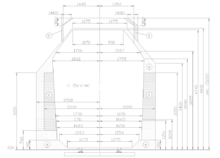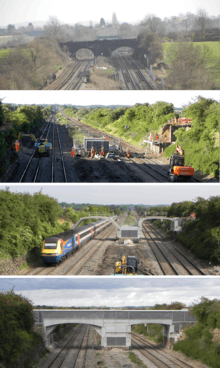Structure gauge


The structure gauge, also called the minimum clearance outline, is the minimum height and width of tunnels and bridges as well as the minimum height and width of the doors that allow a rail siding access into a warehouse. In addition, the term may apply to the minimum distance to railway platforms (passenger or freight), buildings, electrical equipment boxes, railway signal equipment, third rails or to supports for overhead lines from the track. The width of a narrow cut can also affect the maximum loading gauge.
The difference between the structure gauge and the loading gauge is called the "clearance". The amount of clearance between the loading gauge and the structure gauge depends on the speed of the train, due to the train wobbling, so a train may be able to get past a restricted clearance by travelling at slow speed.
The term can also be applied to the minimum size of road tunnels and bridges, as well as doors into automobile repair shops, bus garages, filling stations, residential garages, multi-storey car parks and warehouses.
Trivia
A nationally reported [1] anniversary celebrated in May 2018 in Russia near St. Petersburg, the bridge of stupidity; Not less than 150 trucks were caught between 2009 and 2018 despite warnings also to pickup truck drivers at the deep passage, of which no less than 14 in the first 5 months of the year.[2]
Only after various incidents in Frauenfeld (Switzerland) at an underpass a warning device is created. Lowering the underpass was out of the question.[3]
See also
- Air draft, applies to bridges across navigable waterways
- Berne gauge
- Clearance car
- Disadvantages of third rail (additional infrastructure restrictions)
- Engineering tolerance
- Loading gauge
- Railway platform
- Railway platform height
- Wayobjects
References
- ↑ [https://iz.ru/748591/2018-05-27/peterburzhtcy-podarili-mostu-gluposti-iubileinyi-tort P Iswestija, 27. Mai 2018
- ↑ 150th Truck Gets Stuck Under St. Petersburg's 'Bridge of Stupidity', The Moscow Times, 28. Mai 2018
- ↑ Unterführung wird jetzt deppensicher gemacht
External links
- Transport Canada, Standard Respecting Railway Clearance
- GLOSSARY OF TERMS USED IN RAILROAD HIGH AND WIDE CLEARANCES
- Railway line clearances and car dimensions including weight ..., Volumes 87-90
- www.ipm.fraunhofer.de/railway
- Clearance Guidelines for Industrial Railways (BC)
- Transport Canada